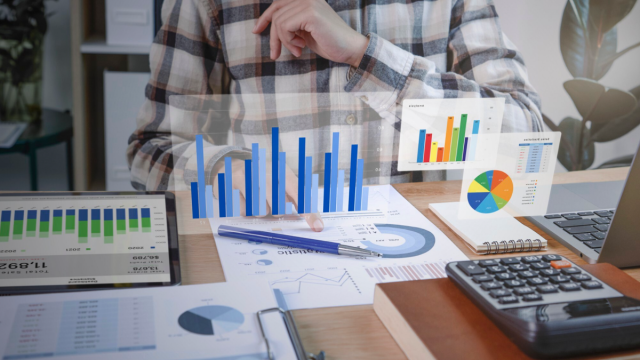Introduction
Contents
An evaluation of data involves analyzing, refining, manipulating, and modelling it for you to discover applicable records, draw conclusions, and make knowledgeable selections. Precise data evaluation allows enterprises to make sound commercial enterprise judgements. There are numerous alternatives for records analysis gear, each with professionals and cons. The key types of data analysis tools include:
● Data Visualization Tools
● Statistical Analysis Tools
● Data Mining Tools
● Big Data Analytics Tools
● Business Intelligence Tools
The complexity of the analysis, specialised analytics requirements, ease of use, skills and resources, interaction with current infrastructure, budget, and the amount and variety of your datasets are all important considerations when choosing data analysis tools. Selecting solutions that enable your organisation to effectively convert data into insights that can be put to use is the aim.
Types of Data Analysis
There are three main types of data analysis: descriptive, predictive, and prescriptive analytics. Each serves a different purpose.
Descriptive Analytics
Finding patterns in historical data and offering insights into past events are the main goals of descriptive analytics. The objective is to comprehend and characterise the existing situation. Data mining, data visualisation, and records aggregation are examples of descriptive analytics strategies. Companies use high powered servers for analytics, data visualization and data mining.
Predictive Analytics
Via techniques along with regression evaluation and predictive modelling, predictive analytics analyzes facts and makes predictions about the destiny. Prescriptive analytics, but, combines machine learning and optimisation to offer pointers and routes. It does this by employing techniques like mathematical optimisation and complicated event processing to determine the optimal course of action.
Data Visualization Tools
Interactive visual representations, such as graphs, charts, and maps, may be made with data visualisation tools, which offers a number of advantages. First of all, by appealing to the human brain and enhancing data comprehension, they make it easier to identify patterns and trends when compared to raw data. These tools also make it easier to analyse big datasets by distilling complex information into visually appealing forms. Additionally, correlations that may be difficult to see in tabular data are highlighted via visualisations, which help in discovering relationships and connections. Powerful data visualisations turn information into captivating stories that offer insightful analysis and compelling storytelling potential.
Statistical Analysis Tools
Statistical analysis tools allow you to apply statistical modeling and analysis techniques to your data. They are useful when you need to:
● Uncover patterns, trends, and relationships within your data
● Make predictions and forecasts based on historical data
● Test hypotheses and assumptions with statistical tests
● Model and simulate complex processes
Some popular statistical analysis tools include: SAS, SPSS (Statistical Package for the Social Sciences), R, Python
Data Mining Tools
Data mining equipment appoints algorithms to discover styles and relationships within datasets, using techniques like clustering, category, and regression to extract valuable insights. One of the maximum extraordinary of them is RapidMiner, which is an incorporated environment for various data mining techniques, machine learning, and predictive analytics. It’s far a simple to apply and adaptable tool. The free and open-source KNIME Analytics Platform allows for the visual construction of analytics components including statistics, machine learning, and deep learning through the use of a modular data pipelining architecture. Another popular open-source machine learning programme for data mining is called Weka. It has an interactive interface that makes it easy to apply methods quickly even if you don’t know how to programme. It offers a variety of algorithms for data preprocessing, classification, regression, and visualisation.
Machine Learning Tools
Machine learning (ML) is revolutionizing data analysis by applying algorithms that learn from data to make predictions or decisions without explicit programming. Machine learning technology that offers pre-built models for obligations like photograph popularity, predictive analytics, and natural language processing, like TensorFlow, PyTorch, and Scikit-learn, democratise the area. These open-source libraries provide simple APIs, extensive documentation, and enable developers to employ advanced techniques without deep expertise in ML algorithms, facilitating the rapid development of competitive machine learning capabilities.
Big Data Analytics Tools
Big data analytics involves examining extensive and diverse datasets to uncover hidden patterns, correlations, market trends, and customer preferences, aiding organizations in making more informed business decisions. The demanding situations of large information analytics encompass dealing with overwhelming information volumes, integrating various information types and sources, and addressing the regular inflow of new facts, posing difficulties in timely analysis because of the high pace. Additionally, concerns arise regarding data veracity, as linking, matching, cleansing, and transforming data across systems become intricate due to its diverse origins.
Several technologies have emerged to help overcome these big data analytics challenges such as Hadoop, Spark, Kafka
Business Intelligence Tools
Business intelligence (BI) tools are designed to help analysts and business users understand and derive insights from their data. BI tools extract, easy, and organise data from an employer’s structures and show it in visually appealing dashboards, reviews, and visualisations. As a result, agencies are better equipped to make business selections by way of seeing developments, styles, and opportunities inside their operations.
Many of the most broadly used BI gear are Looker, power BI, and Tableau.
Choosing the Right Tool
With the multitude of data analysis tools available, figuring out the high quality that suits your needs entails considering numerous key elements. When selecting a data analysis tool, recollect the dataset size, and evaluation needs (data mining, records, machine learning), and prioritize functions like actual-time analytics, data visualization, and reporting. Additionally, determine the infrastructure, selecting among cloud-based totally and on-premises options based on scalability and hardware necessities.
Deciding on the most suitable data analysis tool will empower your group to gain the clearest, innermost insights from your records. The time invested in nicely comparing and enforcing those equipment pays long-term dividends via faster, higher analysis to tell impactful enterprise decisions.


